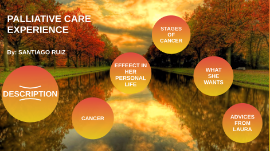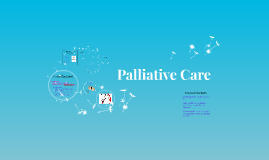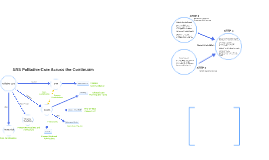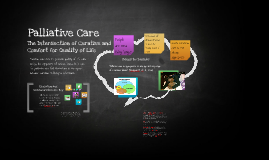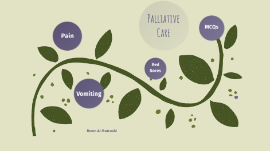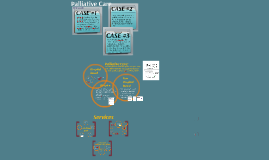Palliative Care
Transcript: Stidor Hospice Meaning of the the illness Loss of dignity Dependency Fear Time Concerns about caregivers Grief and loss "Total pain": suffering comes from symptoms and impairment to physical, psychological, spiritual and social equilibrium Curative txs are foregone During end of life + 12 m for families Prognosis of 6 m or less Specific to End of Life ANOREXIA & CACHEXIA Hormonal manipulation Discontinuing medications Privacy FATIGUE, WEAKNESS, ASTHENIA Causes Treatment of Symptoms Look at previous treatments Palliative Care Metoclpramide, chlropromazine, haloperidol Ondansetron, or other 5HT3, dexamethasone for chemo/radiation related Metoclopramine, erythromycin for gastrolparesis Haloperidol, dexamethasone, octeotide, scopolamine for MBO Haloperidol for kidney failure Metoclopramide for liver Zofran for CHF Fatigue Dyspnea Depression Altertations in body image Prevalence: about 15-60% RF: younger, prior hx, uncontrolled sx, type of illness, existential concerns and spirituality Tx: pharmacotherapy, pscyhotherapy, ECT Coping Methods Palliative Care: Look for reversible causes If in line with goals of care, palliative chemo, radiotherapy or endobronchial brachytherapy Linctus (honey or cough syrup) Centrally acting opioid or benzonatate Bronchodilators, steroids, expectorants may help 50 y/o female who presents with pathological fracture is found to have lung cancer throughout skeleton and liver. Agrees to hospice but doesn't want to be DNR. Intubated y/o male with MG. Has living will stating that he doesn't want intubated for more than 14 days, but has been for 24 days. Is alert enough to answer questions, but has significant ICU delerium. Tried to extubate 2x. Looking into trach and LTC placement vs comfort care. Ambulatory, office and home based programs Early in disease can improve outcomes Prognosis Meds Midazolam Levomepromazine Chlopromazine Phenobarbital Propofol CPR witness WATCH Withdrawing care Communicate what to expect Use patient friendly terms Protocol for withdrawal Abondonment issues NAUSEA & VOMITING psych support & coordination of care 80 y/o female intubated in the field for sustained apnea. Has told friend she never wants life support, but son lives in CA and is DPOA and wants to see her before making any decisions. He takes three days to get there. Recommendations Addressing Sexual Health Interdisciplinary team: chaplains, social workers, psychiatrist, pscyhologists Support for family members Patients want us to ask about spiritual needs Navigation of care plans Services Often not addressed--most patients say it is important and want to discuss it and feel that theirs is lacking We need to be doing a better job of setting these up during well visits. Guidelines suggest when any terminal illness is diagnosed. Important to remind family to look at these guidelines for help in making decisions NOT EUTHANASIA for: pain, dyspnea, agitated delirium convulsions, severe psychological distress establishing goals Relaxation Modify activity level Cool air in face Pulm rehab O2 BiPAP Airway debulking and stents Helium/oxygen Acupuncture Treatments Common, multi-dimensional symptom Treat underlying cause Counsel on coping strategies that conserve energy and good sleep hygiene Steroids, psychostimulants may help Moderate exercise and yoga may help Active Dying Hope Family and social support Spititual beliefs and religious community Denial Economic circumstances Hospital based Services Causes Nausea Constipation Taste alterations Dyspnea Depression Watch the family member’s behavior in the waiting room to determine if he or she is an appropriate candidate (ie, relatively calm without exhibition of aggressive actions or excessive display of emotions) to bear witness to the resuscitation. Ask the physician in charge for permission to invite the family member into the resuscitation room. Tell the family member about the patient’s condition before he or she is taken into the resuscitation room. Caution the family member to be prepared for what he or she will see and hear. Help the family member understand physician and nursing activities. Associated with Poor Quality of Life in last 2 weeks 1. Hospitalizations 2. Being in ICU Treatments CASE #3 Megestrol Gluccorticoids Dronabinol Anabolic steroids Omega-3s DHA Amino acids Mirtazapine Growth hormone Decisional Capacity Anticipate the effects including the risks Reassurance Place bleeding lung in dependent position Urgent sedation may be required ICU Concerns CASE #1 Prevalence: over 50% 2nd most common reason to do palliative sedation Anorexia: loss of appetite or reduced caloric intake Cachexia: weight loss of more than 10% of premorbid weight 5-20% of CHF 60% of COPD 85% of CA 20-75% of CKD Family satisfaction improves with good communication, junior clinician giving info, avoiding contradictory info, complete info Improves psychological outcomes for families Meet before hand Understand the family (emotions, inter-family dynamics) Getting started







